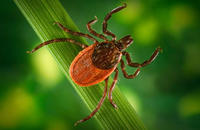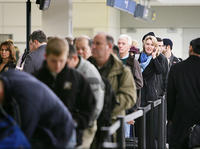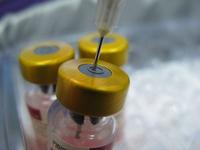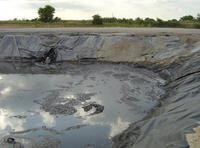-
UN warns of potential food crisis
A UN Food and Agriculture Organization official warned that countries are not doing enough to increase food production to meet rising demand and that the world could be headed for a global food crisis; global food production must rise by 70 percent in order to meet the estimated demand for food; food prices have already soared in recent months and in 2010 food prices increased by 25 percent; rising prices sparked food riots in Egypt and Tunisia, which contributed to the overthrow of their governments; large disasters and droughts have significantly reduced crop yields across the world; as supply has fallen, demand has spiked due to population growth and increased use of food to manufacture biofuels
-
-
Controversy of Kansas biosecurity lab continues

KSU attracted the $650 million National Bio and Agro-Defense Facility for making vaccines and anti-virals to combat the world’s most dangerous animal diseases, beating out the competition during a multi-year screening process; in addition, KSU is planning a 26 April open house for a brand-new “innovation campus” west of Kansas City that will provide graduate level and professional science master’s degree programs (targeted versions of traditional academic programs) as well as industry training in animal health, food safety, and bio-security for more than 120 companies located in the “Kansas City animal health corridor”; critics say that building such a lab in Kansas — one of the largest livestock producing states, and a state which lies at the nation’s transportation crossroads and in the middle of Tornado Alley — is not such a good idea
-
-
Border agents intercept "destructive" Pakistani insects in Oakland
The Khapra beetle, which is native to India, can eat its way through up to 70 percent of grain stores to which it has access; it was eradicated in the United States in 1966, and has been subject to federal quarantine since then; U.S. border agents in the Port of Oakland discover — and destroy — the larva in a shipment from Pakistan
-
-
Countries closely monitor Japanese food for radiation
On Saturday, Japan announced that radiation was detected in spinach and milk produced near the Fukushima nuclear plant; the levels were low enough to not pose a long-term threat to human health, but they were above the national safety level, so the Japanese government has stopped sales of food products from near the damaged plant; countries importing food products from Japan are on alert
-
-
Ticks identified as cause of lethal disease in China

In 2006 villagers in Anhui Province in central China began dying of an illness characterized by high fever, gastrointestinal distress, and a depressed platelet count; researchers suspected anaplasmosis, an infection spread by ticks caused by the bacterium Anaplasma phagocytophilum – but they found neither bacterial DNA nor antibodies against it; each spring since then the disease has struck with a vengeance, killing up to 30 percent of those infected in six provinces of China; scientists have now identified the enemy
-
-
Cholera outbreak in Haiti projected to infect twice as many people
U.S. researchers fear that Haiti’s cholera epidemic could be far worse than initially projected; new models estimate that nearly 800,000 people will be infected with cholera, almost double initial estimates; nine months after the 7.0 magnitude earthquake that shook Haiti last year, cholera cases began to appear for the first time in nearly a hundred years; public health officials are currently debating how to stem the spread of cholera by pursuing vaccination, antibiotics, or sanitation; Harvard researchers are advocating for the use of all three
-
-
The health effects of airport security scanners
The Transportation Security Administration (TSA) has begun to use whole-body imaging scanners as a primary screening measure on travelers passing through airport security checkpoints; one type of scanner employs millimeter wave technology, which delivers no ionizing radiation; the second type of scanner currently deployed at airports, however, uses backscatter X-rays that expose the individual being screened to very low levels of ionizing radiation; what are the health implications of these scanners? Two prominent radiologists offer answers
-
-
Stemming the spread of disease at airports

With roughly two million people flying each day and spending hours in confined areas where they will come into close contact with potentially infected people, air travel poses a serious challenge to public health officials seeking to contain major disease outbreaks; last month public health officials scrambled to contain a potential mass outbreak of measles after a woman flew through three U.S airports, coming into contact with thousands of people; a CDC report recommends using infrared thermal scanners to detect passengers with fevers as that is an easily recognizable symptom and it is a common indicator of most infectious diseases
-
-
Official: U.S. safe from Japanese radiation

U.S nuclear officials said that there was very little chance that harmful levels of radiation from Japan’s nuclear reactors would reach Hawaii or the west coast of the United States; the head of the Nuclear Regulatory Commission (NRC) also said nuclear plants in the United States were designed to withstand natural disasters like earthquakes and tsunamis; readings from radiation sensors placed on the west coast have not detected any increases in radiation levels and experts do not expect any increases; Japanese utilities have flooded two nuclear reactors with sea water in a desperate attempt to cool them down and prevent a meltdown; the NRC has dispatched two nuclear experts to Japan to assist with efforts to keep three damaged reactors from melting down
-
-
Future of U.S. nuclear plans uncertain after Japanese nuclear crisis

As Japan continues its struggle to control its nuclear reactors, the future of the U.S. nuclear industry has become increasingly uncertain; nuclear power had emerged as the bipartisan solution to easing America’s dependency on oil; in February 2010, President Obama announced $8.3 billion in loan guarantees to energy companies to build the first new nuclear power plants in the United States in almost thirty years; some lawmakers have called for a moratorium and stricter safety regulations, while others are urging for a more measured response; Energy Secretary Stephen Chu and Gregory B. Jaczko, the chairman of the Nuclear Regulatory Commission, will testify before the House Energy and Commerce committee on Wednesday
-
-
Supreme Court ruling renders vaccine manufacturers immune to lawsuits

The Supreme Court ruled in favor of vaccine manufacturers declaring that they could not be sued in state court for damages as a result of design-defects in their products; the court found six to two that the National Childhood Vaccine Injury Act protects vaccine manufacturers from design-defect claims; the law was passed in response to a massive increase in litigation against vaccine manufacturers that led to a shortage of vaccines; Justice Sotomayor and Ginsberg dissented; the two argued that the decision leaves a regulatory void and insufficient oversight over vaccine manufacturers; proponents say that this helps stabilize the vaccine market and protects children
-
-
BARDA awards Novavax $179 million contract
Maryland-based Novavax, a biopharmaceutical company that produces Virus-Like Particle (VLP)-based recombinant vaccines, has been awarded a $179 million contract by Department of Health and Human Services’ Office of Biomedical Advanced Research and Development Authority (BARDA) to continue developing its new vaccines for seasonal and pandemic flu
-
-
Vaxinnate secures BARDA contract
New Jersey-based Vaxinnate Corp. said it has secured a contract from the Biomedical Advanced Research and Development Authority (BARDA), the research and development authority part of the Department of Health and Human Services (HHS), for up to $196.6 million to help develop its seasonal and pandemic flu vaccines
-
-
Radioactive waste contaminates drinking water, EPA does nothing

Recent Environmental Protection Agency (EPA) documents show that Pennsylvania’s drinking water has been contaminated with radioactive waste from natural gas drilling; energy companies have been extracting natural gas with a new drilling technique called “hydrofracking”; this process results in millions of gallons of wastewater that is contaminated with dangerous chemicals like highly corrosive salts, carcinogens, and radioactive elements; EPA documents reveal the process has been contaminating drinking water supplies across the country with radioactive waste; in Pennsylvania more than 1.3 billion gallons of radioactive wastewater was trucked to plants that could not process out the toxins before it released the water into drinking supplies
-
-
U.S. scrambling to contain potential measles outbreak
Public health officials in the United States are scrambling to prevent a massive measles outbreak after an infected woman came into contact with thousands of people as she travelled through three U.S. airports; measles is a highly contagious respiratory virus that can be transmitted through coughing or sneezing; the Centers for Disease Control and Prevention (CDC) is in the process of tracking down passengers that may have come into contact with the infected woman and closely monitoring airport employees; each year the disease kills approximately 200,000 people around the world, primarily children, but thanks to widespread vaccinations against measles, fatality rates in the United States are low
-
More headlines
The long view
We Ran the C.D.C.: Kennedy Is Endangering Every American’s Health
Nine former leaders of the Centers for Disease Control and Prevention (CDC), who served as directors or acting directors under Republican and Democratic administrations, serving under presidents from Jimmy Carter to Donald Trrump, argue that HHS Secretary Roert F. Kennedy Jr. poses a clear and present danger to the health of Americans. He has placed anti-vaxxers and conspiracy theorists at top HHS positions, and he appears to be guided by a hostility to science and a belief in bizarre, unscientific approaches to public health.
